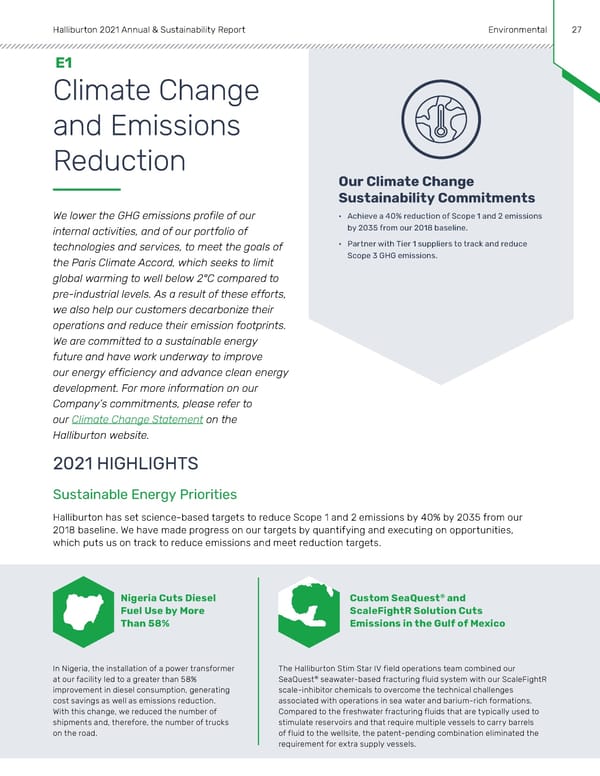Halliburton 2021 Annual & Sustainability Report Environmental 27 E1 Climate Change and Emissions Reduction Our Climate Change Sustainability Commitments We lower the GHG emissions profile of our • Achieve a 40% reduction of Scope 1 and 2 emissions internal activities, and of our portfolio of by 2035 from our 2018 baseline. technologies and services, to meet the goals of • Partner with Tier 1 suppliers to track and reduce the Paris Climate Accord, which seeks to limit Scope 3 GHG emissions. global warming to well below 2°C compared to pre-industrial levels. As a result of these efforts, we also help our customers decarbonize their operations and reduce their emission footprints. We are committed to a sustainable energy future and have work underway to improve our energy efficiency and advance clean energy development. For more information on our Company’s commitments, please refer to our Climate Change Statement on the Halliburton website. 2021 HIGHLIGHTS Sustainable Energy Priorities Halliburton has set science-based targets to reduce Scope 1 and 2 emissions by 40% by 2035 from our 2018 baseline. We have made progress on our targets by quantifying and executing on opportunities, which puts us on track to reduce emissions and meet reduction targets. Nigeria Cuts Diesel Custom SeaQuest® and Fuel Use by More ScaleFightR Solution Cuts Than 58% Emissions in the Gulf of Mexico In Nigeria, the installation of a power transformer The Halliburton Stim Star IV field operations team combined our at our facility led to a greater than 58% SeaQuest® seawater-based fracturing fluid system with our ScaleFightR improvement in diesel consumption, generating scale-inhibitor chemicals to overcome the technical challenges cost savings as well as emissions reduction. associated with operations in sea water and barium-rich formations. With this change, we reduced the number of Compared to the freshwater fracturing fluids that are typically used to shipments and, therefore, the number of trucks stimulate reservoirs and that require multiple vessels to carry barrels on the road. of fluid to the wellsite, the patent-pending combination eliminated the requirement for extra supply vessels.
 Environmental Page 1 Page 3
Environmental Page 1 Page 3